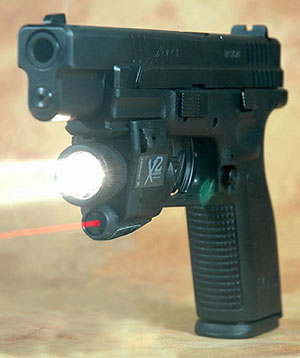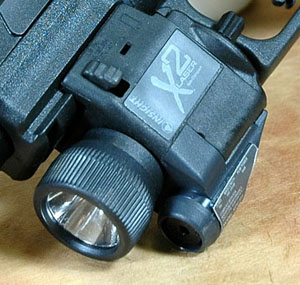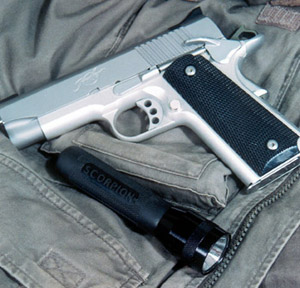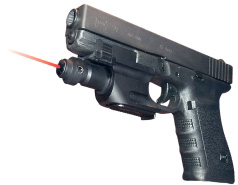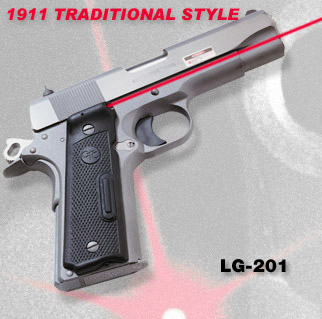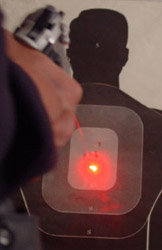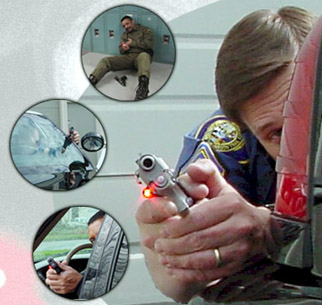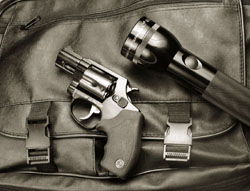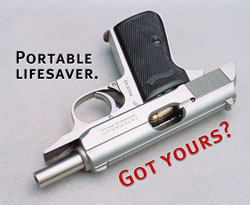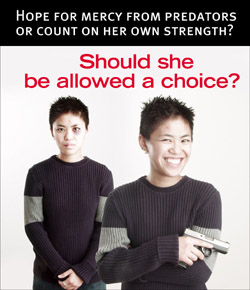By Sarah Thompson, M.D.
[email protected]
“You don’t need to have a gun; the police will protect you.”
“If people carry guns, there will be murders over parking spaces and neighborhood basketball games.”
“I’m a pacifist. Enlightened, spiritually aware people shouldn’t own guns.”
“I’d rather be raped than have some redneck militia type try to rescue me.”
How often have you heard these statements from misguided advocates of victim disarmament, or even woefully uninformed relatives and neighbors? Why do people cling so tightly to these beliefs, in the face of incontrovertible evidence that they are wrong? Why do they get so furiously angry when gun owners point out that their arguments are factually and logically incorrect?
How can you communicate with these people who seem to be out of touch with reality and rational thought?
One approach to help you deal with anti-gun people is to understand their psychological processes. Once you understand why these people behave so irrationally, you can communicate more effectively with them.
Defense Mechanisms
Projection
About a year ago I received an e-mail from a member of a local Jewish organization. The author, who chose to remain anonymous, insisted that people have no right to carry firearms because he didn’t want to be murdered if one of his neighbors had a “bad day”. (I don’t know that this person is a “he”, but I’m assuming so for the sake of simplicity.) I responded by asking him why he thought his neighbors wanted to murder him, and, of course, got no response. The truth is that he’s statistically more likely to be murdered by a neighbor who doesn’t legally carry a firearm1 and more likely to be shot accidentally by a law enforcement officer.1
How does my correspondent “know” that his neighbors would murder him if they had guns? He doesn’t. What he was really saying was that if he had a gun, he might murder his neighbors if he had a bad day, or if they took his parking space, or played their stereos too loud. This is an example of what mental health professionals call projection – unconsciously projecting one’s own unacceptable feelings onto other people, so that one doesn’t have to own them.3 In some cases, the intolerable feelings are projected not onto a person, but onto an inanimate object, such as a gun,4 so that the projector believes the gun itself will murder him.
Projection is a defense mechanism. Defense mechanisms are unconscious psychological mechanisms that protect us from feelings that we cannot consciously accept.5 They operate without our awareness, so that we don’t have to deal consciously with “forbidden” feelings and impulses. Thus, if you asked my e-mail correspondent if he really wanted to murder his neighbors, he would vehemently deny it, and insist that other people want to kill him.
Projection is a particularly insidious defense mechanism, because it not only prevents a person from dealing with his own feelings, it also creates a world where he perceives everyone else as directing his own hostile feelings back at him.6
All people have violent, and even homicidal, impulses. For example, it’s common to hear people say “I’d like to kill my boss”, or “If you do that one more time I’m going to kill you.” They don’t actually mean that they’re going to, or even would, kill anyone; they’re simply acknowledging anger and frustration. All of us suffer from fear and feelings of helplessness and vulnerability. Most people can acknowledge feelings of rage, fear, frustration, jealousy, etc. without having to act on them in inappropriate and destructive ways.
Some people, however, are unable consciously to admit that they have such “unacceptable” emotions. They may have higher than average levels of rage, frustration, or fear. Perhaps they fear that if they acknowledge the hostile feelings, they will lose control and really will hurt someone. They may believe that “good people” never have such feelings, when in fact all people have them.
This is especially true now that education “experts” commonly prohibit children from expressing negative emotions or aggression. Instead of learning that such emotions are normal, but that destructive behavior needs to be controlled, children now learn that feelings of anger are evil, dangerous and subject to severe punishment.7To protect themselves from “being bad”, they are forced to use defense mechanisms to avoid owning their own normal emotions. Unfortunately, using such defense mechanisms inappropriately can endanger their mental health; children need to learn how to deal appropriately with reality, not how to avoid it.8
(This discussion of psychological mechanisms applies to the average person who is uninformed, or misinformed, about firearms and self-defense. It does not apply to the anti- gun ideologue. Fanatics like Charles Schumer know the facts about firearms, and advocate victim disarmament consciously and willfully in order to gain political power. This psychological analysis does not apply to them.)
Denial
Another defense mechanism commonly utilized by supporters of gun control is denial. Denial is simply refusing to accept the reality of a given situation.9 For example, consider a woman whose husband starts coming home late, has strange perfume on his clothes, and starts charging flowers and jewelry on his credit card. She may get extremely angry at a well-meaning friend who suggests that her husband is having an affair. The reality is obvious, but the wronged wife is so threatened by her husband’s infidelity that she is unable to accept it, and so denies its existence.
Anti-gun people do the same thing. It’s obvious that we live in a dangerous society, where criminals attack innocent people. Just about everyone has been, or knows someone who has been, victimized. It’s equally obvious that law enforcement can’t protect everyone everywhere 24 hours a day. Extensive scholarly research demonstrates that the police have no legal duty to protect you10 and that firearm ownership is the most effective way to protect yourself and your family.11 There is irrefutable evidence that victim disarmament nearly always precedes genocide.12 Nonetheless, the anti-gun folks insist, despite all evidence to the contrary, that “the police will protect you”, “this is a safe neighborhood” and “it can’t happen here”, where “it” is everything from mugging to mass murder.
Anti-gun people who refuse to accept the reality of the proven and very serious dangers of civilian disarmament are using denial to protect themselves from the anxiety of feeling helpless and vulnerable. Likewise, gun owners who insist that “the government will never confiscate my guns” are also using denial to protect themselves from the anxiety of contemplating being forcibly disarmed and rendered helpless and vulnerable.
Reaction Formation
Reaction formation is yet another defense mechanism common among the anti-gun folks. Reaction formation occurs when a person’s mind turns an unacceptable feeling or desire into its complete opposite.13 For example, a child who is jealous of a sibling may exhibit excessive love and devotion for the hated brother or sister.
Likewise, a person who harbors murderous rage toward his fellow humans may claim to be a devoted pacifist and refuse to eat meat or even kill a cockroach.14 Often such people take refuge in various spiritual disciplines and believe that they are “superior” to “less civilized” folks who engage in “violent behavior” such as hunting, or even target shooting. They may devote themselves to “animal welfare” organizations that proclaim that the rights of animals take precedence over the rights of people.15 This not only allows the angry person to avoid dealing with his rage, it allows him actually to harm the people he hates without having to know he hates them.
This is not meant to disparage the many wonderful people who are pacifists, spiritually inclined, vegetarian, or who support animal welfare. The key issue is not the belief itself, but rather the way in which the person experiences and lives his beliefs. Sincere practitioners seek to improve themselves, or to be helpful in a gentle, respectful fashion. They work to persuade others peacefully by setting an example of what they believe to be correct behavior. Sincere pacifists generally exhibit good will towards others, even towards persons with whom they might disagree on various issues.
Contrast the sincere pacifist or animal lover with the strident, angry person who wants to ban meat and who believes murdering hunters is justified in order to “save the animals” – or the person who wants to outlaw self- defense and believes innocent people have the obligation to be raped and murdered for the good of society. For example, noted feminist Betty Friedan said “that lethal violence even in self defense only engenders more violence.”16 The truly spiritual, pacifist person refrains from forcing others to do what he believes, and is generally driven by positive emotions, while the angry person finds “socially acceptable” ways to harm, abuse, or even kill, his fellow man.
In the case of anti-gun people, reaction formation keeps any knowledge of their hatred for their fellow humans out of consciousness, while allowing them to feel superior to “violent gun owners”. At the same time, it also allows them to cause serious harm, and even loss of life, to others by denying them the tools necessary to defend themselves. This makes reaction formation very attractive from a psychological point of view, and therefore very difficult to counteract.
Defense Mechanisms Are Not Mental Illnesses
Defense mechanisms are normal. All of us use them to some extent, and their use does not imply mental illness. Advocates of victim disarmament may be misguided or uninformed, they may be stupid, or they may be consciously intent on evil, but that doesn’t necessarily mean they are “mentally ill”.
Some defense mechanisms, however, are healthier than others. A safe general rule is that a defense is healthy if it helps you to function better in your personal and professional life, and unhealthy if it interferes with your life, your relationships, or the well-being of others. Young children utilize projection and denial much more commonly than do healthy adults. On the other hand, “if projection is used as a defense mechanism to a very great extent in adult life, the user’s perception of external reality will be seriously distorted.”17
Defense mechanisms are also frequently combined, so that an anti-gun person may use several defense mechanisms simultaneously. For example, my unfortunate correspondent uses projection to create a world in which all his neighbors want to murder him. As a result, he becomes more angry and fearful, and needs to employ even more defense mechanisms to cope. So he uses projection to attribute his own rage to others, he uses denial that there is any danger to protect himself from a world where he believes he is helpless and everyone wants to murder him, and he uses reaction formation to try to control everyone else’s life because his own is so horribly out of control.
Also, it’s important to remember that not all anti-gun beliefs are the result of defense mechanisms. Some people suffer from gun phobia18, an excessive and completely irrational fear of firearms, usually caused by the anti-gun conditioning they’ve been subjected to by the media, politicians, so-called “educators,” and others. In some cases, gun phobia is caused by an authentic bad experience associated with a firearm. But with all due respect to Col. Jeff Cooper, who coined the term “hoplophobia” to describe anti-gun people, most anti-gun people do not have true phobias. Interestingly, a person with a true phobia of guns realizes his fear is excessive or unreasonable,19 something most anti-gun folks will never admit.
Defense mechanisms distort reality
Because defense mechanisms distort reality in order to avoid unpleasant emotions, the person who uses them has an impaired ability to recognize and accept reality. This explains why my e-mail correspondent and many other anti-gun people persist in believing that their neighbors and co- workers will become mass murderers if allowed to own firearms.
People who legally carry concealed firearms are actually less violent and less prone to criminal activity of all kinds than is the general population.20 A person who has a clean record, has passed an FBI background check, undergone firearms training, and spent several hundred dollars to get a permit and a firearm, is highly unlikely to choose to murder a neighbor. Doing so would result in his facing a police manhunt, a trial, prison, possibly capital punishment, and the destruction of his family, job, and reputation. Obviously it would make no sense for such a person to shoot a neighbor – except in self-defense. Equally obviously, the anti-gun person who believes that malicious shootings by ordinary gun owners are likely to occur is not in touch with reality.21
The Common Thread: Rage
In my experience, the common thread in anti-gun people is rage. Either anti-gun people harbor more rage than others, or they’re less able to cope with it appropriately. Because they can’t handle their own feelings of rage, they are forced to use defense mechanisms in an unhealthy manner. Because they wrongly perceive others as seeking to harm them, they advocate the disarmament of ordinary people who have no desire to harm anyone. So why do anti-gun people have so much rage and why are they unable to deal with it in appropriate ways? Consider for a moment that the largest and most hysterical anti-gun groups include disproportionately large numbers of women, African- Americans and Jews. And virtually all of the organizations that claim to speak for these “oppressed people” are stridently anti-gun. Not coincidentally, among Jews, Blacks and women there are many “professional victims” who have little sense of identity outside of their victimhood.
Identity as Victim
If I were to summarize this article in three sentences, they would be:
(1) People who identify themselves as “victims” harbor excessive amounts of rage at other people, whom they perceive as “not victims.”
(2) In order psychologically to deal with this rage, these “victims” utilize defense mechanisms that enable them to harm others in socially acceptable ways, without accepting responsibility or suffering guilt, and without having to give up their status as “victims.”
(3) Gun owners are frequently the targets of professional victims because gun owners are willing and able to prevent their own victimization.
Thus the concept of “identity as victim” is essential. How and why do members of some groups choose to identify themselves as victims and teach their children to do the same? While it’s true that women, Jews, and African- Americans have historically been victimized, they now participate in American society on an equal basis. And other groups, most notably Asian-Americans, have been equally victimized, and yet have transcended the “eternal victim” mentality.
Why, for example, would a 6’10” NBA player who makes $10 million a year see himself as a “victim”? Why would a successful, respected, wealthy, Jewish physician regard himself as a “victim”? Conversely, why might a wheelchair bound woman who lives on government disability NOT regard herself as a victim?
I would argue it’s because the basketball player and the physician believe that their identities are dependent on being victims – not because they have actually been victimized, but because they’re members of groups that claim victim status. Conversely, the disabled woman was probably raised to believe that she is responsible for her own success or failure.
In fact, many people who have been victims of actual violent crime, or who have survived war or civil strife, support the right of self-defense. The old saying is often correct: “a conservative is a liberal who has been mugged.”
Special Treatment and Misleading Leaders
Two reasons for these groups to insist on “victim” status seem likely. First, by claiming victim status, members of these groups can demand (and get) special treatment through quotas, affirmative action, reparations, and other preferential treatment programs.
Second, these people have been indoctrinated to believe that there is no alternative to remaining a victim forever. Their leaders remind them constantly that they are mistreated in every imaginable way (most of them imaginary!), attribute every one of life’s misfortunes to “racism” or “sexism” or “hate crimes”, and dream up ever more complex schemes for special treatment and favors.22 These leaders are the ones who preach that the entire Black experience is slavery and racism, or that Jewish history before and after the Holocaust is irrelevant,23 or that happily married women are really victims of sexual slavery.24
Likewise, the NAACP is suing firearms manufacturers to put them out of business,25 and is especially opposed to the inexpensive pistols that enable the poor to defend themselves in gang-ridden inner cities. The Department of Housing and Urban Development (HUD) proposed evicting anyone who dares to keep a tool of self-defense in any of its crime-infested housing projects. Jewish leaders, especially those in the politically correct “Reform” branch, preach that gun control is “a solemn religious obligation”,26 contrary to the teachings of their sacred scriptures and their own history.27 Law enforcement agencies falsely teach women that they are safest if they don’t resist rapists and robbers,28 while women’s organizations advocate gun control, thus rendering women and their children defenseless.
Victimhood is good business for organizations that foster victim status. As victims, the members depend upon the organization to protect them, and the organization in turn relies on members for funding and political power. In the interest of self-preservation, these organizations work hard at preserving hatred and bigotry and at keeping their members defenseless – and therefore dependent.
Anti-gun groups love victims!
From my observations, pro-victimhood is a feature of all of the anti-gun special interest groups, not just the ones mentioned here. Every organization that supports gun control apparently wants its members to be helpless, terrified and totally dependent on someone else to control every aspect of their lives. It doesn’t matter whether it’s a religious, racial, ethnic, political, social, or charitable group. From Handgun Control, Inc. to the Anti- Defamation League to the Million Mom March, they all want you to live in fear. In this scheme, soccer moms are “victims” just as much as are inner-city minorities.
If these organizations truly cared about the people for whom they claim to speak, they would encourage safe and responsible firearms ownership. They would help people to learn how to defend themselves and their families so that they wouldn’t have to live in fear. They would tell everyone that one of the wonderful things about being an American is that you have the right to keep and bear arms, the right to defend yourself, and how these rights preserve the right to be free.
The psychological price of being a victim
In our current society, victimhood has many perceived benefits, but there are some serious drawbacks. Victims tend to see the world as a scary and threatening place. They believe that others treat them differently, unfairly, and even maliciously – and that they are helpless to do anything about it. This belief, that they are being mistreated and are helpless to resist, generates tremendous rage, and often, serious depression.
But for victims to show rage openly can be dangerous, if not outright suicidal. For example, a battered woman who screams at or hits her attacker may provoke worse beatings or even her own murder. And a person who successfully defends himself loses his status as “victim.” For someone whose entire identity is dependent on being a victim, the loss of victim status is just as threatening as loss of life.
So, unable psychologically to cope with such rage, people who view themselves as victims: (1) use defense mechanisms to displace it into irrational beliefs about neighbors killing each other, and the infallibility of police protection, and (2) attempt to regain control by controlling gun owners, whom they wrongly perceive as “the enemy”.
Say NO to being a victim!
But no one needs to be a victim! Quite simply, it’s not very easy to victimize a person who owns and knows how to use a firearm. If most women owned and carried firearms, rapes and beating would decrease.29 Thugs who target the elderly and disabled would find honest work once they realized they were likely to be looking down the barrel of a pistol or shotgun. It’s nearly impossible to enslave, or herd into concentration camps, large numbers of armed people.
Communicating with anti-gun people
How can you communicate more effectively with an anti-gun person who is using unhealthy defense mechanisms? There are no quick and easy answers. But there are a few things you should keep in mind.
Anger and attacks do not work
Most gun owners, when confronted by an anti-gun person, become angry and hostile. This is understandable, because gun owners increasingly face ridicule, persecution and discrimination. (If you don’t believe this, ask yourself if anyone would seriously introduce legislation to ban African- Americans, women, or Jews from post offices, schools, and churches. Even convicted felons aren’t banned from such places – but peaceful armed citizens are!) But an angry response is counterproductive.
It’s not helpful to attack the person you’re trying to persuade. Anything that makes him feel more fearful or angry will only intensify his defenses. Your goal is to help the person feel safe, and then to provide experiences and information that will help him to make informed decisions.
Be Gentle
You should never try to break down a defense mechanism by force. Remember that defense mechanisms protect people from feelings they cannot handle, and if you take that protection away, you can cause serious psychological harm. And because defense mechanisms operate unconsciously, it won’t do any good to show an anti-gun person this article or to point out that he’s using defense mechanisms. Your goal is gently and gradually to help the person to have a more realistic and rational view of the world. This cannot be done in one hour or one day.
As you reach out to people in this way, you need to deal with both the illogical thought processes involved and the emotional reactions that anti-gun people have to firearms. When dealing with illogical thought processes, you are attempting to use reason and logic to convince the anti-gun person that his perception of other people and his perception of firearms are seriously inaccurate. The goal is to help him to understand that armed citizens and firearms are not threats, and may even save his life.
Reversing Irrational thoughts
The Mirror Technique
One approach that can be helpful is simply to feed back what the anti-gun person is telling you, in a neutral, inquisitive way. So, when replying to my anonymous e-mail correspondent (above), I might respond, “So you fear if your neighbors had guns, they would use them to murder you. What makes you think that?” When you simply repeat what the person has said, and ask questions, you are not directly challenging his defenses. You are holding up a mirror to let him see his own views. If he has very strong defenses, he can continue to insist that his neighbors want to murder him. However, if his defenses are less rigid, he may start to question his position.
Another example might be, “Why do you think that your children’s schoolteachers would shoot them?” You might follow this up with something like, “Why do you entrust your precious children to someone you believe would murder them?” Again, you are merely asking questions, and not directly attacking the person or his defenses.
Of course the anti-gun person might continue to insist that the teachers really would harm children, but prohibiting them from owning guns would prevent it. So you might ask how using a gun to murder innocent children is different from stabbing children with scissors, assaulting them with baseball bats, or poisoning the milk and cookies.
It’s important to ask “open-ended” questions that require a response other than “yes” or “no”. Such questions require the anti-gun person actually to think about what he is saying. This will help him to re-examine his beliefs. It may also encourage him to ask you questions about firearms use and ownership.
The “What Would You Do?” Technique
Once you have a dialogue going with an anti-gun person, you might want to insert him into a hypothetical scenario, although doing so is a greater threat to his defenses, and is therefore more risky. You might ask how he would deal with a difficult or annoying co-worker. He will likely respond that he would never resort to violence, but “other people” would, especially if they had guns. (Projection again.) You can then ask him who these “other people” are, why they would shoot a co-worker, and what the shooter would gain by doing so.
Don’t try to “win” the argument. Don’t try to embarrass the person you’re trying to educate. Remember that no one likes to admit that his deeply held beliefs are wrong. No one likes to hear “I told you so!” Be patient and gentle. If you are arrogant, condescending, hurtful or rude to the anti-gun person, you will only convince him that gun owners are arrogant, hurtful people – who should not be trusted with guns!
Defusing Emotional reactions
The “You Are There” Technique
Rational arguments alone are not likely to be successful, especially since many people “feel” rather than “think”. You also need to deal with the emotional responses of the anti-gun person. Remember that most people have been conditioned to associate firearms with dead toddlers. So you need to change the person’s emotional responses along with his thoughts.
One way to do this is to put the anti-gun person (or his family) at a hypothetical crime scene and ask what he would like to have happen. For example, “Imagine your wife is in the parking lot at the supermarket and two men grab her. One holds a knife to her throat while the other tears her clothes off. If I see this happening and have a gun, what should I do? What would happen next? What if after five minutes, the police still haven’t arrived?”
Just let him answer the questions and mentally walk through the scenario. Don’t argue with his answers. You are planting seeds in his mind than can help change his emotional responses.
The Power of Empathy
Another emotion-based approach that is often more successful is to respond sympathetically to the plight of the anti-gun person.
Imagine for a moment how you would feel if you believed your neighbors and co-workers wanted to kill you and your family, and you could do nothing at all about it except to wait for the inevitable to occur.
Not very pleasant, is it?
This is the world in which opponents of armed self-defense live. All of us have had times in our lives when we felt “different” and had to contend with hostile schoolmates, co- workers, etc. So we need to invoke our own compassion for these terrified people. Say something like, “It must be awful to live in fear of being assaulted by your own neighbors. I remember what it was like when I was the only (Jew, Mormon, African-American, Republican) in my (class, football team, workplace) – and even then I didn’t think anyone was going to kill me.” It’s essential that you sincerely feel some compassion and empathy; if you’re glib or sarcastic, this won’t work.
Using empathy works in several ways. First, it defuses a potentially hostile interaction. Anti-gun people are used to being attacked, not understood, by advocates of gun rights. Instead of an “evil, gun-toting, extremist”, you are now a sympathetic, fellow human being. This may also open the door for a friendly conversation, in which you can each discover that your “opponent” is a person with whom you have some things in common. You may even create an opportunity to dispel some of the misinformation about firearms and self-defense that is so prevalent.
This empathy technique is also useful for redirecting, or ending, a heated argument that has become hostile and unproductive. It allows you to escape from the dead end of “guns save lives” vs. “the only reason to have a gun is to murder children.” With empathy you can reframe the argument entirely. Instead of arguing about whether more lives are saved or lost as a result of gun ownership, you can comment on how terrifying it must be to live in a country where 80 million people own guns “solely for the purpose of murdering children”.
You should not expect any of these approaches to work immediately; they won’t. With rare exceptions, the anti-gun person is simply not going to “see the light,” thank you profusely, and beg you to take him shooting. What you are doing is putting tiny chinks into the armor of the person’s defenses, or planting seeds that may someday develop into a more open mind or a more rational analysis. This process can take months or years. But it does work!
Corrective Experiences
Perhaps the most effective way to dissolve defense mechanisms, however, is by providing corrective experiences30. Corrective experiences are experiences that allow a person to learn that his ideas about gun owners and guns are incorrect in a safe and non-threatening way. To provide a corrective experience, you first allow the person to attempt to project his incorrect ideas onto you. Then, you demonstrate that he is wrong by your behavior, not by arguing.
For example, the anti-gun person will unconsciously attempt to provoke you by claiming that gun owners are uneducated “rednecks,” or by treating you as if you are an uneducated “redneck.” If you get angry and respond by calling him a “stupid, liberal, socialist”, you will prove his point. However, if you casually talk about your M.B.A., your trip to the Shakespeare festival, your vegetable garden, or your daughter’s ballet recital, you will provide him with the opportunity to correct his misconceptions.
If you have used the above techniques, then you have already provided one corrective experience. You have demonstrated to the frightened, anti-gun person that gun owners are not abusive, scary, dangerous and sub-human monsters, but normal, everyday people who care about their families, friends and even strangers.
As many gun owners have already discovered, the most important corrective experiences involve actually exposing the fearful person to a firearm. It is almost never advisable to tell someone that you carry a concealed firearm, but there are ways to use your own experience favorably.
For example, if you’re dealing with an anti-gun person with whom you interact regularly and have a generally good relationship – a coworker, neighbor, church member, etc. – you might indirectly refer to concealed carry. You should never say anything like “I’m carrying a gun right now and you can’t even tell,” especially because in some states that would be considered illegal, “threatening” behavior. But you might consider saying something like, “I sometimes carry a firearm, and you’ve never seemed to be uncomfortable around me.” Whether to disclose this information is an individual decision, and you should consider carefully other consequences before using this approach.
First-hand experience
Ultimately, your goal is to take the anti-gun person shooting. Some people will accept an invitation to accompany you to the range, but others are too frightened to do so, and will need some preliminary experience.
First, you want to encourage the anti-gun person to have some contact with a firearm in whatever way feels most comfortable to him. Many people seem to believe that firearms have minds of their own and shoot people of their own volition. So you might want to start by inviting him simply to look at and then handle an unloaded firearm. This also provides you the opportunity to show the inexperienced person how to tell whether a firearm is loaded and to teach him the basic rules of firearms safety.
Encourage the newcomer to ask questions and remember that your role is to present accurate information in a friendly, responsible and non-threatening way. This is a good time to offer some reading material on the benefits of firearms ownership. But be careful not to provide so much information that it’s overwhelming. And remember this is not the time to launch into anti-government rants, the New World Order, conspiracy theories, or any kind of political talk!
Next, you can invite your friend to accompany you to the shooting range. (And if you’re going to trust each other with loaded guns, you should consider yourselves friends!) Assure him that no one will force him to shoot a gun and he’s free just to watch. Let him know in advance what he will experience and what will be expected of him. This includes such things as the need for eye and ear protection, a cap, appropriate clothing, etc. Make sure you have a firearm appropriate for your guest should s/he decide to try shooting. This means a lower caliber firearm that doesn’t have too much recoil. If your guest is a woman, make sure the firearm will fit her appropriately. Many rifles have stocks that are too long for small women, and double-stack semi-autos are usually too large for a woman’s hand.
Remember that just visiting the range can be a corrective experience. Your guest will learn that gun owners are disciplined, responsible, safety-conscious, courteous, considerate, and follow the rules. He will see people of all ages, from children to the elderly, male and female, enjoying an activity together. He will not see a single “beer-swilling redneck” waving a firearm in people’s faces.
In my experience, most people who visit a range will decide they do want to try shooting. Remember to make sure your guest understands all the safety rules and range rules before allowing him to handle a firearm. If you don’t feel competent to teach a newcomer to shoot, ask an instructor or range master to assist. Remember to provide lots of positive feedback and encouragement. If you’re lucky, you’ll recruit a new firearms enthusiast.
But even if your guest decides that shooting is “not for him”, he will have learned many valuable lessons. He will know basic rules of firearms safety, and how to clear a firearm should he need to do so. This may well save his life someday. He will know that guns do not fire unless a person pulls the trigger. He will know that gun owners are friendly, responsible people, not very different from him. Even if he chooses not to fire a gun ever again, he will be less likely to fear and persecute gun owners. And who knows – a few months or years later he may decide to become a gun owner.
Why these techniques do not always work
You should remember that you will not be successful with all anti-gun people. Some people are so terrified and have such strong defenses, that it’s not possible for someone without professional training to get through. Some people have their minds made up and refuse to consider opening them. Others may concede that what you say “makes sense,” but are unwilling to challenge the forces of political correctness. A few may have had traumatic experiences with firearms from which they have not recovered.
You will also not be successful with the anti-gun ideologues, people like Charles Schumer and Dianne Feinstein. These people have made a conscious choice to oppose firearms ownership and self-defense. They almost always gain power, prestige, and money from their anti-gun politics. They are not interested in the facts or in saving lives. They know the facts and understand the consequences of their actions, and will happily sacrifice innocent people if it furthers their selfish agenda. Do not use these techniques on such people. They only respond to fears of losing the power, prestige and money that they covet.31
Conclusion
By better understanding advocates of civilian disarmament, and by learning and practicing some simple techniques to deal with their psychological defenses, you will be much more effective in your efforts to communicate with anti-gun people. This will enable you to be more successful at educating them about the realities of firearms and self- defense, and their importance to our liberty and safety.
Educating others about firearms is hard work. It’s not glamorous, and it generally needs to be done one person at a time. But it’s a very necessary and important task. The average American supports freedom of speech and freedom of religion, whether or not he chooses to exercise them. He supports fair trials, whether or not he’s ever been in a courtroom. He likewise needs to understand that self- defense is an essential right, whether or not he chooses to own or carry a gun.
© 2000, Sarah Thompson.
Dr. Thompson is Executive Director of Utah Gun Owners Alliance, www.utgoa.org and also writes The Righter, www.therighter.com, a monthly column on individual rights.
Notes
1 Lott, John R., Jr. 1998. More Guns, Less Crime. University of Chicago Press. Pp. 11-12; Proposition B: More Security Or Greater Danger?, St. Louis Post-Dispatch. March 21, 1999.
2 Lott 1998, Pp. 1-2.
3 Kaplan, Harold M. and Sadock, Benjamin J. 1990. Pocket Handbook of Clinical Psychiatry. Williams & Wilkins. P. 20.
4Brenner, Charles. 1973. An Elementary Textbook of Psychoanalysis (rev. ed.). Anchor Books. Pp. 91-93; Lefton, Lester A. 1994. Psychology (5th edition). Allyn & Bacon. Pp. 432-433.
5 Brenner 1973. P. 91.
6 Kaplan and Sadock 1990, p. 20; Lefton 1994, p. 432.
7 Talbott, John A., Robert E. Hales and Stuart C. Yudofsky, eds. 1988. Textbook of Psychiatry. American Psychiatric Press. P.137.
8 “Kids Suspended for Playground Game.” Associated Press. April 6, 2000.
9 Lightfoot, Liz. “Gun Return to the Nursery School Toy Chest.” The London Telegraph. May 22, 2000. Kaplan and Sadock 1990, p. 20; Lefton 1994, p. 433.
10 Stevens, Richard W. 1999. Dial 911 and Die. Mazel Freedom Press. [Analyzes the law in 54 U.S. jurisdictions]; see, e.g., Bowers v. DeVito, 686 F.2d 616, 618 (7th Cir. 1982) [no federal constitutional right to police protection.]
11 Kleck, Gary and Gertz, Marc. 1995. Armed Resistance to Crime: The Prevalence and Nature of Self- Defense with a Gun. Journal of Criminal Law & Criminology. Vol. 86 (Fall), pp. 150-187.
12 Simkin, Jay, Zelman, Aaron, and Rice, Alan M. 1994. Lethal Laws. Jews for the Preservation of Firearms Ownership.
13 Kaplan and Sadock 1990, p. 20; Lefton 1994, p. 433.
14 Brenner 1973, p. 85.
15 Veith, Gene Edward, Jr. 1993. Modern Fascism: Liquidating the Judeo-Christian Worldview. Saint Louis: Concordia Publishing. Pp. 39-40 [fascism exalts nature, animals and environment].
16 Japenga, A. 1994. Would I Be Safer with a Gun? Health. March/April, p. 54.
17 Brenner 1973, p. 92.
18 Kaplan and Sadock 1990, p. 219.
19 American Psychiatric Association. 1994. Diagnostic and Statistical Manual of Mental Disorders, Fourth Edition. P. 410.
20 Lott 1998, pp. 11-12.
21 Most American gun owners are not violent criminals and will not be potential killers. “The vast majority of persons involved in life-threatening violence have a long criminal record and many prior contacts with the justice system.” Elliott, Delbert S. 1998. Life Threatening Violence is Primarily a Crime Problem: A Focus on Prevention. University of Colorado Law Review. Vol. 69 (Fall), pp. 1081-1098, at 1093.
22 Sowell, Thomas. 2000. Blacks and bootstraps. Jewish World Review (Aug.14).
23x Wein, Rabbi Berel. 2000. The return of a Torah scroll and confronting painful memories. Jewish World Review (July 12).
24 Dworkin, Andrea. “Terror, Torture and Resistance“.
25 Mfume, Kweisi, speech at the 90th annual NAACP meeting, July 12, 1999.
26 Yoffie, Rabbi Eric H. Speech supporting the Million Mom March, May 14, 2000.
27 “If someone comes to kill you, arise quickly and kill him.” The Talmud, Tractate Sanhedrin. 1994. The Schottenstein Edition. New York: Mesorah Publications. Vol. 2, 72a.
28 Rape and Sexual Assault, Dean of Students Office for Women’s Resources and Services McKinley Health Education Dept., University Police, University of Illinois; Hazelwood, R. R. & Harpold, J. 1986. Rape: The Dangers of Providing Confrontational Advice, FBI Law Enforcement Bulletin. Vol. 55, pp. 1-5.
29 Lott 1998, pp. 78, 134-37.
30 Frank, Jerome D. 1961. Persuasion and Healing. The Johns Hopkins Press. Pp. 216-217.
31 Richardson, H. L. 1998. Confrontational Politics. Gun Owners Foundation. 1
Permission is granted to distribute this article in its entirety, so long as full copyright information and full contact information is given for JPFO.
Copyright © 2000 Sarah Thompson, MD
Published by
Jews For The Preservation of Firearms Ownership, Inc.
P.O. Box 270143
Hartford, WI 53027
Phone (262) 673-9745
www.jpfo.org

